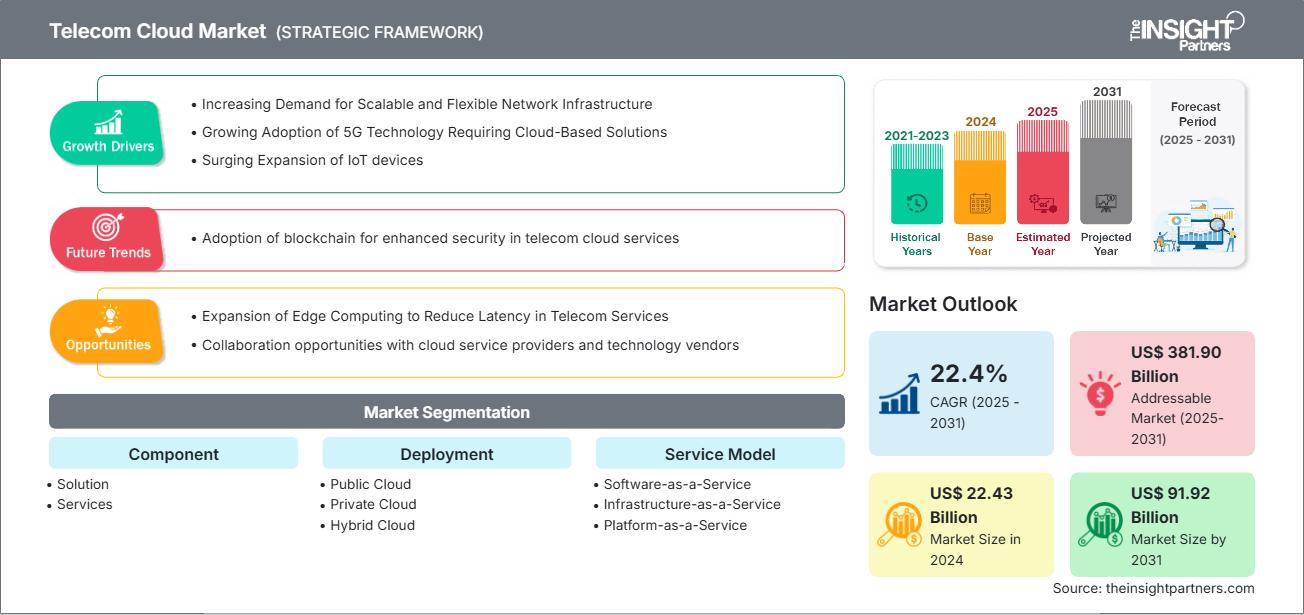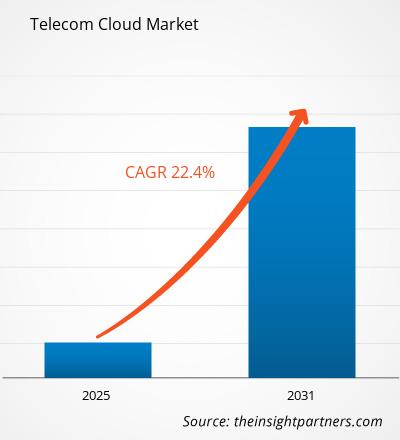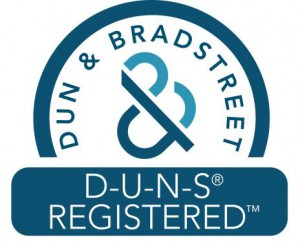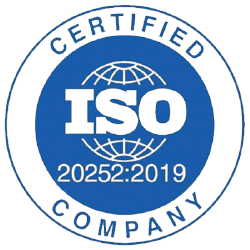预计到2031年,电信云市场规模将从2024年的224.3亿美元增至919.2亿美元。预计2025年至2031年期间,该市场的复合年增长率将达到22.4%。
电信云市场分析电信公司采用云技术来提高运营敏捷性、降低资本和运营支出,并加速服务部署。通过利用云,运营商可以动态扩展资源、自动化网络功能、提高容错能力,并快速推出统一通信、内容交付和客户自助服务平台等数字服务。不断增长的数据消耗、对远程工作工具的需求以及对无缝数字体验日益增长的需求,都提升了电信云的重要性。此外,与AWS、Microsoft Azure、Google Cloud和Oracle等超大规模云提供商的合作,正在帮助电信公司解锁分析、网络安全和人工智能方面的高级功能。随着电信网络不断发展以满足高度互联世界的需求,云的采用已不再是可有可无的选择。受5G基础设施投资增加、实时服务需求不断增长以及向软件定义网络和虚拟化云原生系统持续转变的推动,电信云市场未来几年将迎来强劲增长。
电信云市场概览电信云是指将云计算技术集成到电信基础设施和服务中。它使电信运营商能够虚拟化传统网络功能,在云环境中托管服务和应用程序,并以更高的可扩展性和效率管理运营。这种从以硬件为中心到云原生架构的转变正在改变电信云服务的构建、运营和交付方式。它在赋能5G、物联网、边缘计算、人工智能和网络切片等技术方面发挥着关键作用,同时支持消费者和企业细分市场的数字化转型。
您将免费获得任何报告的定制,包括本报告的部分内容,或国家级分析、Excel 数据包,以及为初创企业和大学提供超值优惠和折扣
电信云市场: 战略洞察

-
获取本报告的主要市场趋势。这个免费样本将包括数据分析,从市场趋势到估计和预测。
电信云市场驱动因素和机遇
市场驱动因素:-
5G 部署和网络现代化:
电信运营商正在迅速转向云原生架构,以支持 5G 功能,包括低延迟、高带宽和大规模物联网 (IoT) 支持。云平台为网络切片和边缘计算提供了可扩展且敏捷的基础设施。
-
对经济高效的网络运营的需求不断增长:
云计算无需大量物理基础设施,从而降低了资本和运营支出 (CapEx/OpEx)。虚拟化和软件定义网络 (SDN) 可实现动态资源分配和效率。
-
NFV(网络功能虚拟化)的采用率不断提高:
电信运营商正在虚拟化核心网络功能(例如防火墙、负载均衡器)以在云平台上运行。 NFV 可提高服务敏捷性,并缩短新服务的上市时间。
-
对可扩展且安全的通信服务的需求日益增长:
企业和消费者要求通信服务具备高可用性、移动性和安全性。云原生服务支持快速扩展并与安全和合规性框架集成。
-
物联网和智能设备的兴起:
电信云支持物联网生态系统所需的海量数据处理和分析。智能家居、智能城市和智能行业的增长正在推动基于云的连接解决方案的发展。
市场机遇:
-
边缘计算集成:
边缘云融合支持在用户附近进行实时处理,这对于自动驾驶汽车和 AR/VR 等对延迟敏感的应用至关重要。电信公司可以为垂直行业提供新的边缘即服务模式。
-
人工智能和分析驱动的服务:
将人工智能/机器学习嵌入电信云,可以实现预测性维护、网络优化和客户行为分析。这为增值服务和个性化产品开辟了道路。
-
私有 5G 和混合云解决方案:
企业需要由云基础设施支持的私有 5G 网络,以实现安全、低延迟的通信。电信公司可以提供结合公有资源和私有资源的定制混合云模式。
-
与超大规模企业建立战略合作:
与 AWS、Google Cloud、Microsoft Azure 等建立合作伙伴关系,使电信公司能够利用全球云基础设施和先进的服务。联合开发服务可扩大覆盖范围并提升能力
电信云市场划分为不同的细分市场,以便更清晰地了解其运作方式、增长潜力和最新趋势。以下是大多数行业报告中使用的标准细分方法:
按组件:
-
解决方案:
电信云解决方案涵盖用于网络虚拟化、编排和自动化的软件平台,使电信运营商能够提高整个数字基础设施和服务的敏捷性、可扩展性和运营效率。 -
服务:
电信云服务包括咨询、集成和托管服务,支持部署和优化,帮助运营商加速云采用、降低成本并确保在混合和多云环境中的无缝性能。本地
按部署方式:
- 公有云:公有云为电信公司提供可扩展的基础架构和全球覆盖范围,非常适合经济高效地处理不太敏感的工作负载,并在无需大量 IT 投资的情况下快速实现服务创新。
- 私有云:私有云为管理关键运营的电信公司提供安全、专用的基础架构,为核心网络服务和敏感客户数据提供更高的控制力、合规性和性能。
- 混合云:混合云融合了公有云和私有云的优势,使电信公司能够根据业务需求和合规性跨环境部署工作负载,从而平衡成本、控制力和性能。
按服务模式:
- 软件即服务
- 基础架构即服务
- 平台即服务
按组织规模:
- 中小企业
- 大型企业
按地域:
- 北美
- 欧洲
- 亚太地区
- 拉丁美洲
- 中东和非洲
The Insight Partners 的分析师已详尽阐述了预测期内影响电信云市场的区域趋势和因素。本节还讨论了北美、欧洲、亚太地区、中东和非洲以及南美和中美洲的电信云市场细分和地域分布。
电信云市场报告范围
| 报告属性 | 细节 |
|---|---|
| 市场规模 2024 | US$ 22.43 Billion |
| 市场规模 2031 | US$ 91.92 Billion |
| 全球复合年增长率 (2025 - 2031) | 22.4% |
| 历史数据 | 2021-2023 |
| 预测期 | 2025-2031 |
| 涵盖的领域 |
By 组件
|
| 覆盖地区和国家 |
北美
|
| 市场领导者和主要公司简介 |
|
电信云市场参与者密度:了解其对业务动态的影响
电信云市场正在快速增长,这得益于终端用户需求的不断增长,而这些需求又源于消费者偏好的不断变化、技术进步以及对产品优势的认知度不断提升等因素。随着需求的增长,企业正在扩展其产品线,不断创新以满足消费者需求,并抓住新兴趋势,从而进一步推动市场增长。

- 获取 电信云市场 主要参与者概述
按地区划分的电信云市场份额分析
在电信云市场中,北美在 2024 年占据了主导地位。美国在主要云超大规模提供商(AWS、Azure 和 Google Cloud)以及 AT&T、Verizon 和 T-Mobile 等电信巨头的大力投资下处于领先地位。电信运营商正在构建云原生 5G 核心,拥抱混合/多云战略,并采用网络切片、边缘计算和人工智能驱动的自动化。
电信云市场在每个地区的增长情况不同。这是由于数字技术、政府法规等因素造成的。以下是按地区划分的市场份额和趋势摘要:
1.
市场份额:
占据全球市场的很大一部分关键驱动因素:
- 5G 网络的快速部署增加了对云原生基础设施的需求。
- 电信公司早期采用云技术以及与超大规模合作伙伴(例如 AWS、Azure)合作。
- 自动驾驶汽车和智慧城市等低延迟应用的兴起。
趋势:
越来越多的人使用非接触式支付和移动支付,支付安全性也越来越强。2.欧洲
-
市场份额:
由于早期采用数字商务,市场份额巨大 -
关键驱动因素:
- 欧盟的数字战略推动电信云的采用和数据主权。
- 电信云支持绿色 IT 和网络优化。
- 光纤和 5G 的推出需要可扩展且灵活的云基础设施。
-
趋势:
主权云解决方案的兴起(例如 GAIA-X 项目),电信业转向多云和混合架构,以及基于云的网络基础设施的跨境合作。
3.亚太地区
-
市场份额:
增长最快的地区,市场份额每年都在增长 -
关键驱动因素:
- 高移动和数据使用量推动了对可扩展电信基础设施的需求。
- 印度、中国和东南亚等国家正在推动智慧城市和基于云的电信系统。
-
趋势:
电信-超大规模合作伙伴关系激增,以部署云服务,并增加对 AI 和云原生 BSS/OSS 平台的投资。
4.南美和中美洲
-
市场份额:
市场稳步增长 -
关键驱动因素:
- 城市人口增长推动了电信网络的扩张和现代化。
- 云计算降低了预算受限的电信运营商的资本支出/运营支出。
-
趋势:
巴西和阿根廷等主要经济体更加关注云原生 5G 核心部署。
5.中东和非洲
-
市场份额:
虽然规模小,但增长迅速 -
关键驱动因素:
- 服务欠缺地区对可靠、可扩展网络的需求不断增长。
- 云基础设施对于整个海湾地区的智慧城市至关重要。
-
趋势:
电信基础设施的公私合作伙伴关系不断增加,并逐步向私有云和混合云模式迁移。
由于 AT&T Inc.、Amazon Web Services Inc、Telefonaktiebolaget LM Ericsson、Verizon Communications Inc 等老牌参与者的存在,竞争非常激烈;以及国际商业机器公司 (IBM)。Mavenir(美国)、Athonet(意大利)、IP Infusion(日本)等区域性和利基供应商也在加剧不同地区的竞争格局。
这种激烈的竞争促使公司通过提供以下服务脱颖而出:
- 高级安全功能
- 增值服务
- 有竞争力的定价模式
- 强大的客户支持
机遇与战略举措
- 与 AWS、Microsoft Azure、Google Cloud 合作,利用全球云基础设施并加速电信云的采用。
- 投资开源社区和 Open RAN 标准,以推广可互操作的云原生网络解决方案(例如 Mavenir 和 Altiostar)。
- 开发针对各个行业垂直领域(包括智慧城市、汽车和制造。
- AT&T Inc.
- Amazon Web Services Inc
- Telefonaktiebolaget LM Ericsson
- Verizon Communications Inc
- International Business Machines Corp
- Cisco Systems Inc
- Broadcom Inc
- Microsoft Corp
- Google LLC
- Telstra Corp Ltd
免责声明:以上列出的公司没有按任何特定顺序排名。
在研究过程中分析的其他公司有:
- Intellias
- NTT DATA Group Corporation
- Nokia
- 华为技术有限公司
- Metaswitch Networks
- Cyfuture
- 中国电信Americas, Inc.
- Informatica Inc.
- Check Point Software Technologies Ltd
- Hewlett Packard Enterprise Development LP
- Athonet
- IP Infusion
- Mavenir
- Altiostar
- Radisys
-
爱立信推出 Ericsson On-Demand
2025 年 6 月,爱立信宣布推出 Ericsson On-Demand,这是一种全新的解决方案,以真正的软件即服务 (SaaS) 平台的形式向通信服务提供商 (CSP) 提供核心网络服务。该平台基于 Google Cloud 设计,利用 AI 基础架构和 Google Kubernetes Engine (GKE),并由爱立信进行端到端管理。该解决方案将帮助 CSP 通过完全托管的云原生平台快速设置和发展核心网络服务、降低运营成本并获得业务灵活性。 -
IBM 推出 IBM Guardium 数据安全中心
2024 年 8 月,随着混合云、人工智能和量子相关风险颠覆传统的数据安全范式,IBM 推出了 IBM Guardium 数据安全中心,使组织能够在任何环境中、在其整个生命周期内通过统一控制保护数据。IBM Guardium 数据安全中心提供了组织数据资产的通用视图,使安全团队能够集成工作流并在单个仪表板中同时解决数据监控和治理、数据检测和响应、数据和 AI 安全态势管理以及加密管理。IBM Guardium 数据安全中心包含生成式 AI 功能,可帮助生成风险摘要并提高安全专业人员的工作效率。
《电信云市场规模和预测(2021-2031)》报告对市场进行了详细的分析,涵盖以下领域:
- 电信云市场规模以及涵盖范围内所有关键细分市场的全球、区域和国家/地区预测
- 电信云市场趋势以及市场动态,例如驱动因素、限制因素和关键机遇
- 详细的 PEST 和 SWOT 分析
- 电信云市场分析涵盖关键市场趋势、全球和区域框架、主要参与者、法规和最新市场发展
- 行业格局和竞争分析涵盖市场集中度、热图分析、知名参与者和电信云市场的最新发展
- 详细的公司简介
- 历史分析(2 年)、基准年、预测(7 年)及复合年增长率
- PEST和SWOT分析
- 市场规模、价值/数量 - 全球、区域、国家
- 行业和竞争格局
- Excel 数据集
近期报告
客户评价
购买理由
- 明智的决策
- 了解市场动态
- 竞争分析
- 客户洞察
- 市场预测
- 风险规避
- 战略规划
- 投资论证
- 识别新兴市场
- 优化营销策略
- 提升运营效率
- 顺应监管趋势






















 获取免费样品 - 电信云市场
获取免费样品 - 电信云市场